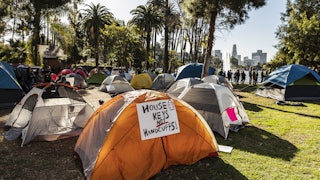By nearly every objective measure, the Biden economy is thriving. The unemployment rate is a very low 3.6 percent. Corporate profits were up 25 percent in December 2021 over the year before, and they continued to rise during the last three months of 2021. Average hourly wages are up 5.5 percent over April 2021 on a nominal basis, and the rate at which workers quit their jobs—a key measure of their confidence about securing a better one—has never been higher. Writing in The New York Times earlier this month, David Streitfeld observed that “for the 158 million who are employed, prospects haven’t been this bright since men landed on the moon.”
Still, the expectation is taking hold that the economy is headed for recession. Gross domestic product, which rose 5.7 percent in 2021, shrank by 1.5 percent on an annualized basis during the first three months of 2022. Inflation is up 8.3 percent over the previous year, and “real” wages (that is, wages with the effects of inflation factored in) have fallen over the past year by 2.6 percent. Consumer confidence has ticked down, and the S&P 500 is very close to a bear market, i.e., a loss in value of 20 percent or more. The Fed is jacking up interest rates to curb inflation, creating considerable risk that a recession will follow. At a news conference last week, President Biden was asked whether a recession was inevitable. He said no, but he conceded that “we have problems that the rest of the world has,” such as food shortages and rising gas prices.
I claim no great wisdom about whether a recession is coming, or, if it comes, whether it will arrive this year or next. Nobody should. But if a recession does come, new research suggests, the result will accelerate economic inequality.
This is somewhat at odds with the prior consensus, which was that social and economic disruption fostered greater economic equality. In 2018, Walter Scheidel, a Stanford professor of classics and history, published a book, The Great Leveler, that identified “the Four Horsemen of Leveling”: “mass mobilization warfare,” “transformative revolution,” “state failure,” and “lethal pandemics.” The tumultuous first half of the twentieth century illustrated Scheidel’s point: Two world wars and a Great Depression bequeathed, in the United States and elsewhere, a half-century trend toward growing (or at least stable) income equality. Only in the late 1970s and early 1980s did income inequality begin to grow steadily worse, a trend that continues unabated today. Recessions provided respite from growing income inequality because they tanked the financial markets where great wealth resided. When the recovery began and the economy started growing again, so did income inequality.
The two-month Covid-19 recession in 2020, which started in February and ended in April, ought to have conformed to Scheidel’s model, because Covid was a lethal pandemic. And indeed, just like the Black Death (1347–51), Covid created a labor shortage, though the mechanism was different. (Bubonic plague killed European peasants in vast workforce-shrinking numbers; Covid prompted working-age Americans to stay home to avoid infection or take care of the kids.)
But while the Covid recession lasted, economic inequality didn’t shrink, as in past recessions; it grew. Unemployment peaked in April at 14.7 percent, putting mainly lower-income workers out on the street because the Covid lockdown affected restaurant and hotel workers disproportionately. Meanwhile, the S&P 500, driven by the pandemic’s bonanza to online commerce, rose through February, March, and April.
After the Covid recession ended, unemployment fell and hourly wages, after a momentary tumble, rose sharply. Since these rising wages were driven largely by low-wage hotel and restaurant workers returning to work, the result ought to have been greater economic equality. But the S&P 500 kept on rising through the end of 2021, enriching the top 10 percent at a much faster pace than wage increases at the bottom—especially after inflation rose high enough to wipe out those wage gains. The Washington Post termed the 2020 Covid recession “the most unequal in modern U.S. history.”
Well, you might say, that was a Covid recession, not a real recession, and everything about the Covid economy is screwy. Real recessions cost rich people serious money. We aren’t in a recession now, but the stock market is faltering and already the world’s 50 richest people, The Wall Street Journal informs us, have lost more than half a trillion dollars in 2022. That’s more than the entire GDP of Sweden. The next recession, when it comes, will do some leveling.
But the new research suggests that once the recession is over and income inequality, predictably, resumes growing alongside economic growth, that inequality will grow faster than before—merely because the recession occurred. Which means recessions do far more to worsen income inequality than to hinder it. That’s new.
The latest study, released earlier this month, comes from an impeccably capitalist source: the Bank for International Settlements, or BIS, an international financial institution based in Basel, Switzerland, that’s owned by 63 central banks, including the U.S. Federal Reserve. The bank looked at 40 recessions in 12 advanced economies: Australia, Canada, France, Germany, Italy, Japan, Norway, Spain, Sweden, Switzerland, the United Kingdom, and the United States. It compared income inequality growth five years after the start of these recessions to income inequality growth during other periods of comparable length. It found, on average, that income inequality grew twice as fast during the periods associated with recessions.
The BIS study measured income inequality by the Gini index, a standard metric but one that tends to understate the type of inequality driven by large increases for the top 1 percent. The 1 percent type of inequality typically comes to a sudden halt during recessions as capital takes its hit, then resumes, as capital recovers, well before the bottom 99 percent get their jobs back and their wages start to rise. Consider the aftermath of the Great Recession of 2007–9. By 2013, the stock market was fully recovered even as unemployment remained stuck at 8 percent and mortgage delinquencies remained above 10 percent. Capital falls much faster during recessions than people do, but it also rebounds much faster after recessions than people do.
Because the Gini index is a broad-based measure, it doesn’t capture very well the fluctuations of capital during and after a recession. Consequently, when you look at recessions as measured by the Gini index, you can expect to see inequality rising quickly during the recession and then rising slowly in the recession’s aftermath.
But that isn’t what you see in the BIS study. What you see is inequality rising quickly during the recession, sure, but also rising quickly after the recession. If the Gini index rises twice as fast as normal after a recession, rest assured that it rises at a much faster rate when you use a metric that takes better account of the lightning-quick recovery of the capital-intensive superrich. The inescapable conclusion is that recessions, though they usually, according to certain measures (not the Gini index), provide momentary respite from growth in income inequality, have the net effect of making income inequality grow at least twice as fast as before. Recessions generate income inequality.
Income inequality returns the favor, according to the BIS study, by making it harder to recover from recessions. In those 12 advanced economies, income taxes have become less progressive since 2000—indeed, they’re close to historical lows—and unemployment insurance has become less generous. That makes it much harder for these advanced economies to spend their way out of economic downturns, which is really the only practical way to shorten them, or to draw down public debt once a recovery is underway. Result: Those slow economic recoveries from recessions that we’ve experienced for the past three decades.
A separate study released this month by Josh Bivens and Asha Banerjee approaches this question from a different angle. Bivens and Banerjee state that pre-tax income inequality reduces budget deficits by distributing income upward to the people who pay the highest marginal tax rates. (Of course, income inequality would reduce budget deficits a lot more if those top marginal rates were anywhere near their levels before President Ronald Reagan dropped them.) When rich people have more money, they pay more in taxes, and fiscal revenues go up. Hurrah! But before you pop any champagne corks, consider that this favorable effect of income inequality is more than outweighed, Bivens and Banerjee say, by the unfavorable effect of making middle-class people poorer, which in turn slows economic growth sufficiently to enlarge deficits. The deficit-bloating effect of these “demand constraints” are half again as large as the deficit-shrinking effect of rich people paying more in taxes. Consequently, income inequality’s net effect is to increase deficits.
Ultimately, Bivens and Banerjee don’t care all that much about the budget deficits of the past four decades, for reasons I won’t go into here. Far more important, they say, is the dwindling economic power of the middle class. Weakened household spending, they argue, constrained economic growth by up to 3.4 percent of GDP per year
and contributed strongly to the very slow recoveries following the most recent three recessions predating the coronavirus recession. The early 1990s recovery was the first one dubbed “jobless,” but employment recovered even more slowly in the early 2000s recovery and the recovery from the Great Recession of 2007–2009.
Recovery from the Covid recession was much faster, they argue, because this time the government spent a lot more on economic recovery.
But Covid was (at least for a while) judged a national emergency. The next recession won’t be—except in the sense that it will make income inequality that much worse, weakening the economic recovery that follows. If you care about economic growth, this new research suggests, you really can’t afford not to care about income inequality.








